Abstract
Cell-free mammalian plasma transformed leukotriene A4 into leukotriene B4. This conversion originated from a soluble enzymatic activity. Heating at 56 degrees C or digestion of plasma with a proteolytic enzyme eliminated formation of leukotriene B4 but not other diastereomeric dihydroxyicosatetraenoic acids formed by nonenzymatic hydrolysis of leukotriene A4. Plasma from several mammals, including guinea pigs, pigs, cows, sheep, rabbits, rats, dogs, and humans, exhibited a qualitatively similar activity. Maximal production of leukotriene B4 occurred in guinea pig plasma near a pH of 7.6; metabolic capacity approached saturation at a substrate concentration of 10 microM. Leukotriene A4 anion was transformed but not its methyl ester. The results suggest that conversion of leukotriene A4 by an enzyme in blood plasma of mammals may provide local gradients of the chemotactic substance leukotriene B4. High interfacial concentrations of leukotriene B4 between the vascular endothelium and leukocytes could facilitate their diapedesis and accumulation at inflammatory sites.
Full text
PDF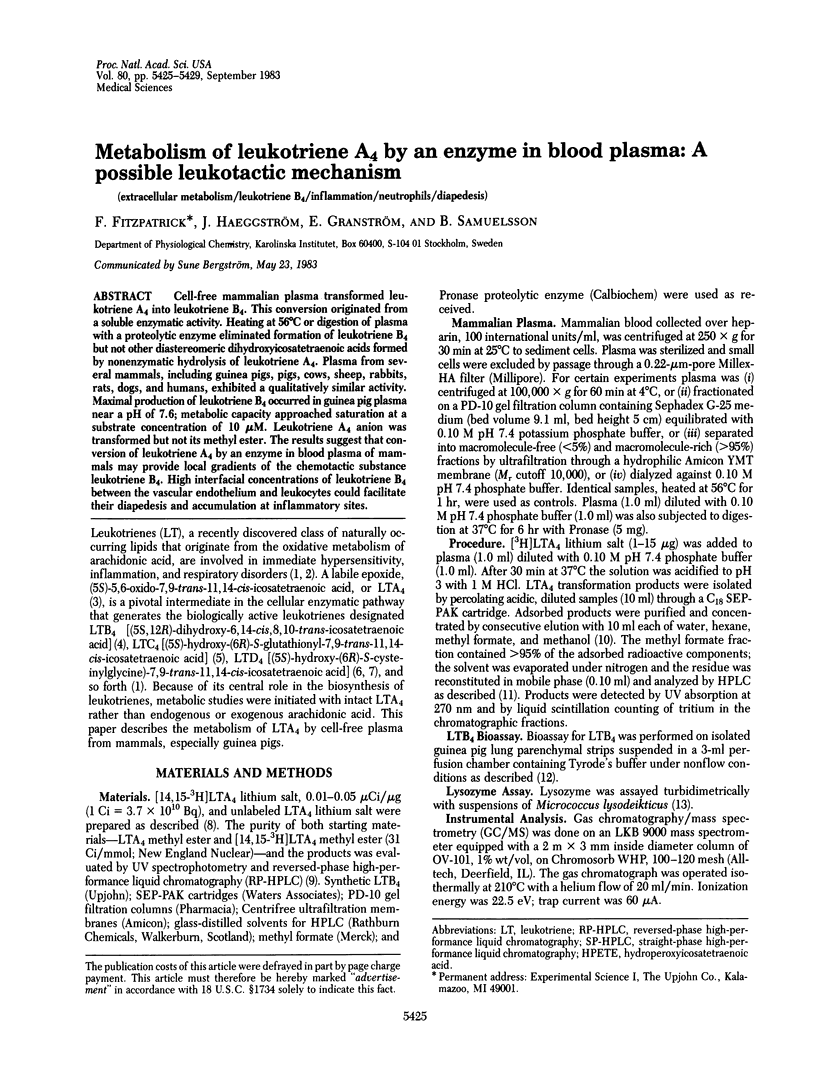
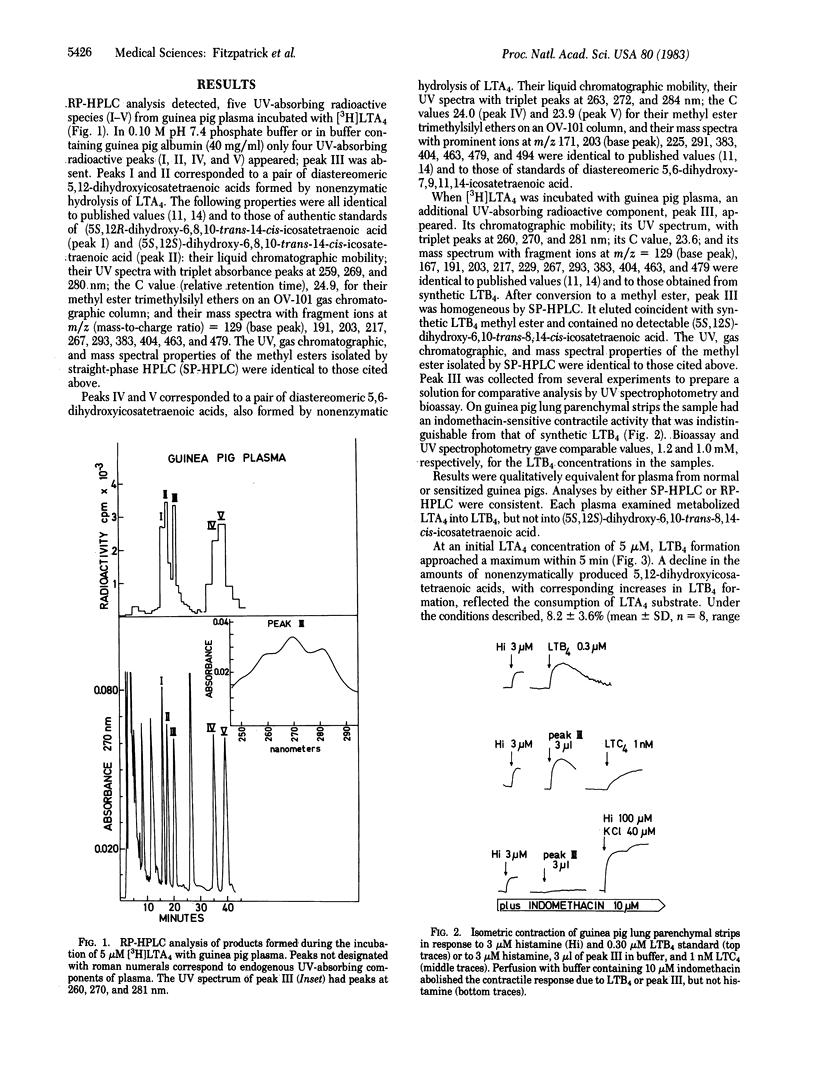
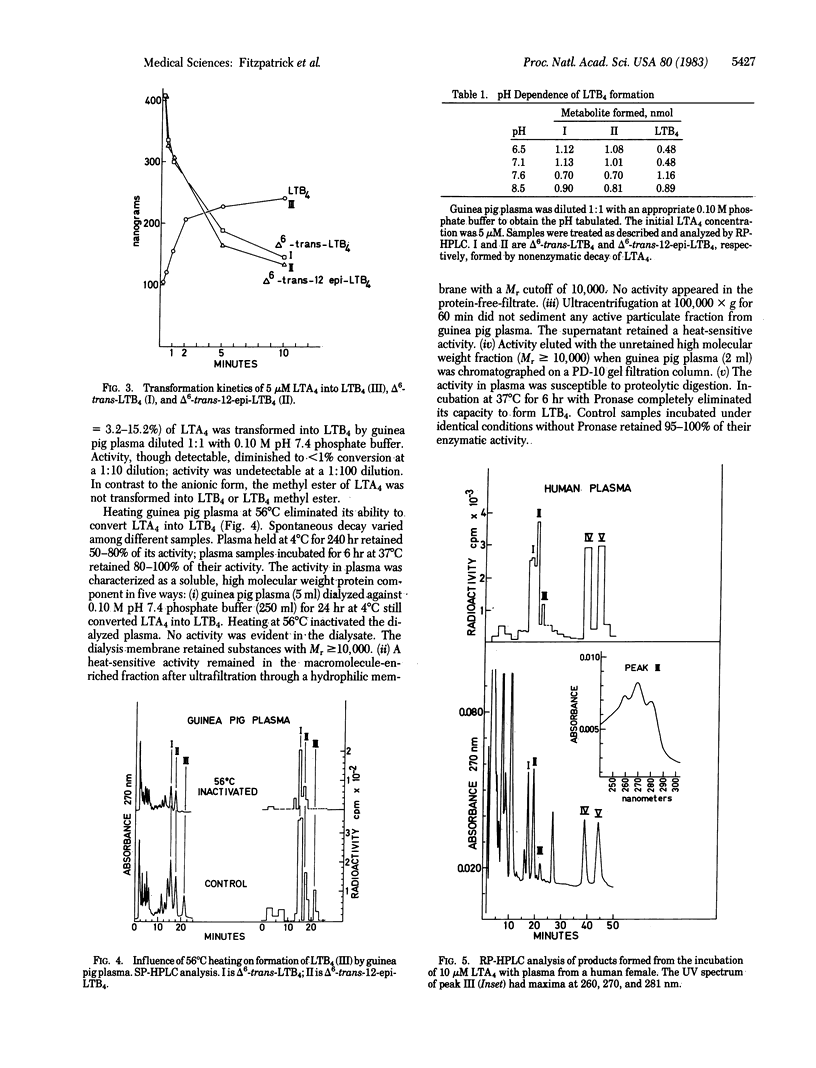
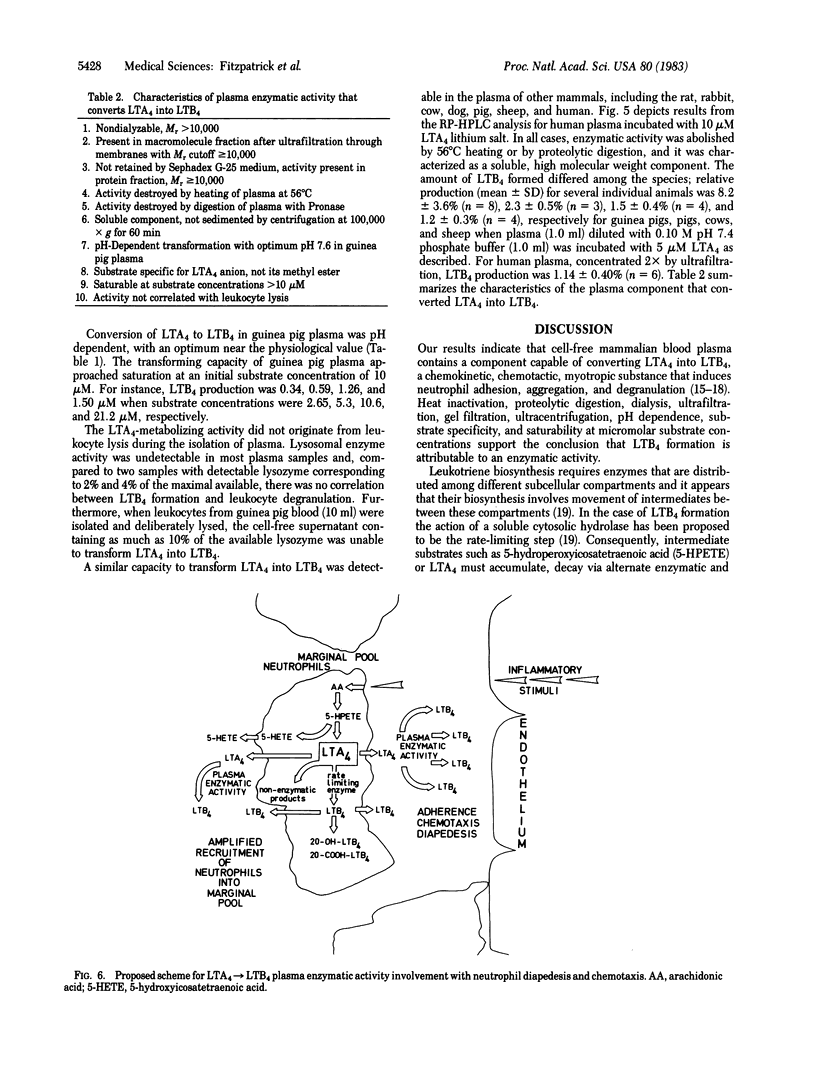
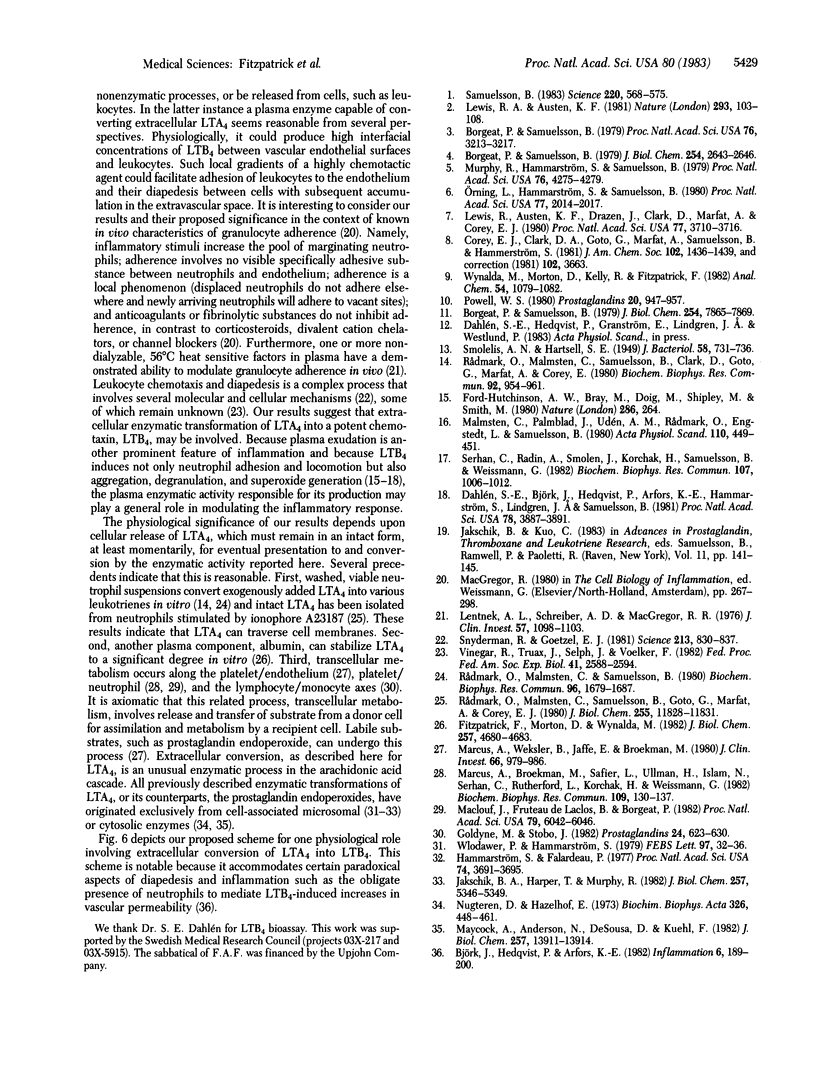
Selected References
These references are in PubMed. This may not be the complete list of references from this article.
- Björk J., Hedqvist P., Arfors K. E. Increase in vascular permeability induced by leukotriene B4 and the role of polymorphonuclear leukocytes. Inflammation. 1982 Jun;6(2):189–200. doi: 10.1007/BF00916243. [DOI] [PubMed] [Google Scholar]
- Borgeat P., Samuelsson B. Arachidonic acid metabolism in polymorphonuclear leukocytes: unstable intermediate in formation of dihydroxy acids. Proc Natl Acad Sci U S A. 1979 Jul;76(7):3213–3217. doi: 10.1073/pnas.76.7.3213. [DOI] [PMC free article] [PubMed] [Google Scholar]
- Borgeat P., Samuelsson B. Metabolism of arachidonic acid in polymorphonuclear leukocytes. Structural analysis of novel hydroxylated compounds. J Biol Chem. 1979 Aug 25;254(16):7865–7869. [PubMed] [Google Scholar]
- Borgeat P., Samuelsson B. Transformation of arachidonic acid by rabbit polymorphonuclear leukocytes. Formation of a novel dihydroxyeicosatetraenoic acid. J Biol Chem. 1979 Apr 25;254(8):2643–2646. [PubMed] [Google Scholar]
- Dahlén S. E., Björk J., Hedqvist P., Arfors K. E., Hammarström S., Lindgren J. A., Samuelsson B. Leukotrienes promote plasma leakage and leukocyte adhesion in postcapillary venules: in vivo effects with relevance to the acute inflammatory response. Proc Natl Acad Sci U S A. 1981 Jun;78(6):3887–3891. doi: 10.1073/pnas.78.6.3887. [DOI] [PMC free article] [PubMed] [Google Scholar]
- Fitzpatrick F. A., Morton D. R., Wynalda M. A. Albumin stabilizes leukotriene A4. J Biol Chem. 1982 May 10;257(9):4680–4683. [PubMed] [Google Scholar]
- Ford-Hutchinson A. W., Bray M. A., Doig M. V., Shipley M. E., Smith M. J. Leukotriene B, a potent chemokinetic and aggregating substance released from polymorphonuclear leukocytes. Nature. 1980 Jul 17;286(5770):264–265. doi: 10.1038/286264a0. [DOI] [PubMed] [Google Scholar]
- Goldyne M. E., Stobo J. D. Human monocytes synthesize eicosanoids from T lymphocyte-derived arachidonic acid. Prostaglandins. 1982 Nov;24(5):623–630. doi: 10.1016/0090-6980(82)90032-6. [DOI] [PubMed] [Google Scholar]
- Hammarström S., Falardeau P. Resolution of prostaglandin endoperoxide synthase and thromboxane synthase of human platelets. Proc Natl Acad Sci U S A. 1977 Sep;74(9):3691–3695. doi: 10.1073/pnas.74.9.3691. [DOI] [PMC free article] [PubMed] [Google Scholar]
- Jakschik B. A., Harper T., Murphy R. C. Leukotriene C4 and D4 formation by particulate enzymes. J Biol Chem. 1982 May 25;257(10):5346–5349. [PubMed] [Google Scholar]
- Jakschik B. A., Kuo C. G. Subcellular localization of leukotriene-forming enzymes. Adv Prostaglandin Thromboxane Leukot Res. 1983;11:141–145. [PubMed] [Google Scholar]
- Lentnek A. L., Schreiber A. D., MacGregor R. R. The induction of augmented granulocyte adherence by inflammation. Mediation by a plasma factor. J Clin Invest. 1976 Apr;57(4):1098–1103. doi: 10.1172/JCI108354. [DOI] [PMC free article] [PubMed] [Google Scholar]
- Lewis R. A., Austen K. F., Drazen J. M., Clark D. A., Marfat A., Corey E. J. Slow reacting substances of anaphylaxis: identification of leukotrienes C-1 and D from human and rat sources. Proc Natl Acad Sci U S A. 1980 Jun;77(6):3710–3714. doi: 10.1073/pnas.77.6.3710. [DOI] [PMC free article] [PubMed] [Google Scholar]
- Lewis R. A., Austen K. F. Mediation of local homeostasis and inflammation by leukotrienes and other mast cell-dependent compounds. Nature. 1981 Sep 10;293(5828):103–108. doi: 10.1038/293103a0. [DOI] [PubMed] [Google Scholar]
- Maclouf J., de Laclos B. F., Borgeat P. Stimulation of leukotriene biosynthesis in human blood leukocytes by platelet-derived 12-hydroperoxy-icosatetraenoic acid. Proc Natl Acad Sci U S A. 1982 Oct;79(19):6042–6046. doi: 10.1073/pnas.79.19.6042. [DOI] [PMC free article] [PubMed] [Google Scholar]
- Malmsten C. L., Palmblad J., Udén A. M., Rådmark O., Engstedt L., Samuelsson B. Leukotriene B4: a highly potent and stereospecific factor stimulating migration of polymorphonuclear leukocytes. Acta Physiol Scand. 1980 Dec;110(4):449–451. doi: 10.1111/j.1748-1716.1980.tb06696.x. [DOI] [PubMed] [Google Scholar]
- Marcus A. J., Broekman M. J., Safier L. B., Ullman H. L., Islam N., Sherhan C. N., Rutherford L. E., Korchak H. M., Weissmann G. Formation of leukotrienes and other hydroxy acids during platelet-neutrophil interactions in vitro. Biochem Biophys Res Commun. 1982 Nov 16;109(1):130–137. doi: 10.1016/0006-291x(82)91575-3. [DOI] [PubMed] [Google Scholar]
- Marcus A. J., Weksler B. B., Jaffe E. A., Broekman M. J. Synthesis of prostacyclin from platelet-derived endoperoxides by cultured human endothelial cells. J Clin Invest. 1980 Nov;66(5):979–986. doi: 10.1172/JCI109967. [DOI] [PMC free article] [PubMed] [Google Scholar]
- Maycock A. L., Anderson M. S., DeSousa D. M., Kuehl F. A., Jr Leukotriene A4: preparation and enzymatic conversion in a cell-free system to leukotriene B4. J Biol Chem. 1982 Dec 10;257(23):13911–13914. [PubMed] [Google Scholar]
- Murphy R. C., Hammarström S., Samuelsson B. Leukotriene C: a slow-reacting substance from murine mastocytoma cells. Proc Natl Acad Sci U S A. 1979 Sep;76(9):4275–4279. doi: 10.1073/pnas.76.9.4275. [DOI] [PMC free article] [PubMed] [Google Scholar]
- Nugteren D. H., Hazelhof E. Isolation and properties of intermediates in prostaglandin biosynthesis. Biochim Biophys Acta. 1973 Dec 20;326(3):448–461. doi: 10.1016/0005-2760(73)90145-8. [DOI] [PubMed] [Google Scholar]
- Orning L., Hammarström S., Samuelsson B. Leukotriene D: a slow reacting substance from rat basophilic leukemia cells. Proc Natl Acad Sci U S A. 1980 Apr;77(4):2014–2017. doi: 10.1073/pnas.77.4.2014. [DOI] [PMC free article] [PubMed] [Google Scholar]
- Powell W. S. Rapid extraction of oxygenated metabolites of arachidonic acid from biological samples using octadecylsilyl silica. Prostaglandins. 1980 Nov;20(5):947–957. doi: 10.1016/0090-6980(80)90144-6. [DOI] [PubMed] [Google Scholar]
- Rådmark O., Malmsten C., Samuelsson B., Clark D. A., Goto G., Marfat A., Corey E. J. Leukotriene A: stereochemistry and enzymatic conversion to leukotriene B. Biochem Biophys Res Commun. 1980 Feb 12;92(3):954–961. doi: 10.1016/0006-291x(80)90795-0. [DOI] [PubMed] [Google Scholar]
- Rådmark O., Malmsten C., Samuelsson B., Goto G., Marfat A., Corey E. J. Leukotriene A. Isolation from human polymorphonuclear leukocytes. J Biol Chem. 1980 Dec 25;255(24):11828–11831. [PubMed] [Google Scholar]
- Rådmark O., Malmsten C., Samuelsson B. Leukotriene A4: enzymatic conversion to leukotriene C4. Biochem Biophys Res Commun. 1980 Oct 31;96(4):1679–1687. doi: 10.1016/0006-291x(80)91367-4. [DOI] [PubMed] [Google Scholar]
- SMOLELIS A. N., HARTSELL S. E. The determination of lysozyme. J Bacteriol. 1949 Dec;58(6):731–736. doi: 10.1128/jb.58.6.731-736.1949. [DOI] [PMC free article] [PubMed] [Google Scholar]
- Samuelsson B. Leukotrienes: mediators of immediate hypersensitivity reactions and inflammation. Science. 1983 May 6;220(4597):568–575. doi: 10.1126/science.6301011. [DOI] [PubMed] [Google Scholar]
- Serhan C. N., Radin A., Smolen J. E., Korchak H., Samuelsson B., Weissmann G. Leukotriene B4 is a complete secretagogue in human neutrophils: a kinetic analysis. Biochem Biophys Res Commun. 1982 Aug;107(3):1006–1012. doi: 10.1016/0006-291x(82)90622-2. [DOI] [PubMed] [Google Scholar]
- Snyderman R., Goetzl E. J. Molecular and cellular mechanisms of leukocyte chemotaxis. Science. 1981 Aug 21;213(4510):830–837. doi: 10.1126/science.6266014. [DOI] [PubMed] [Google Scholar]
- Vinegar R., Truax J. F., Selph J. L., Voelker F. A. Pathway of onset, development, and decay of carrageenan pleurisy in the rat. Fed Proc. 1982 Jul;41(9):2588–2595. [PubMed] [Google Scholar]
- Wlodawer P., Hammarström S. Some properties of prostacyclin synthase from pig aorta. FEBS Lett. 1979 Jan 1;97(1):32–36. doi: 10.1016/0014-5793(79)80045-9. [DOI] [PubMed] [Google Scholar]


